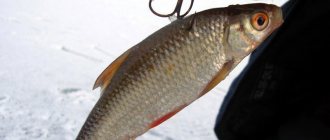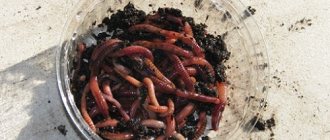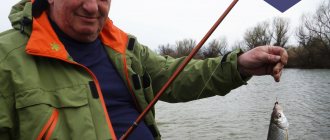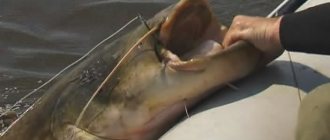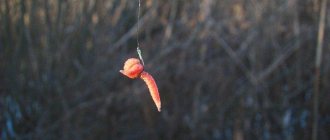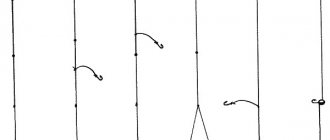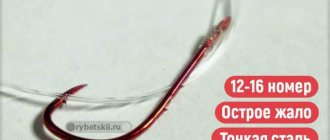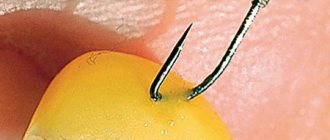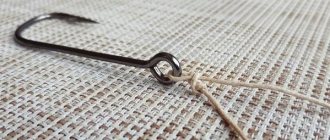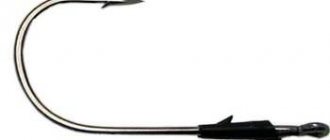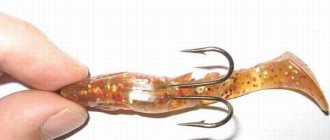Many fishing enthusiasts really like the method of catching predatory fish using live bait. There is still no consensus on the best way to attach live bait. Everyone tries to use their favorite method.
Fishing is especially exciting and romantic in winter, when a zherlitsa is used with great success. Inexperienced fishermen do not always manage to attach live bait correctly, as a result of which they may not catch a catch.
There is no single method for attaching live bait for all cases. This depends on many factors: the type of fish, its inherent activity, time of day, type of bait and live bait used. Let's look at several ways to mount live bait.
Live bait attachment behind the back
Perhaps this option can be called the most popular. You should attach live bait to the girder very carefully and carefully.
In this case, the fisherman should ensure that the ridge is not damaged. Most often, this method uses a tee, occasionally a single or double hook.
When fishing for pike, it is the triple hook option that is used. At the same time, a treble hook is not suitable for some types of live bait, an example is bleak.
If this fish is used as live bait, a special tee is used, which has specific hooks, where the size of one is much smaller than the others.
A thinner material is used to make this specific hook. This ensures a minimum of injuries, which allows you to maximize the life of live bait.
Interestingly, you don’t always need to buy such a hook in a special fishing store; many people successfully make it themselves at home from the means at hand.
First you need to stock up on a double hook, a winding ring and a hook with a ring.
First, the winding ring is equipped with a small hook. After this, a small vinyl tube is attached to the double hook.
Next, the prepared structure of the winding ring and hook is attached to the double. Live bait is attached to a small hook behind the back, while the large hooks remain open.
Doubles and tees
Double and triple fishing hooks are most often used when catching predatory fish. They detect fish very reliably and allow for forced fishing. Doubles and trebles can be used when fishing for predators using live bait and various artificial baits, for example:
- foam fish;
- twister;
- vibrotail;
- wobbler;
- rotating and oscillating spoons.
The triple hook for fishing has proven itself perfectly when catching active fish, when a predator greedily pounces on the bait offered to it. The tee is especially popular among pike fishermen.
When a predator takes the bait more delicately, it is necessary to use doubles, which even sluggish predatory fish can easily swallow. Double hooks are usually used when fishing for pike perch, since its mouth is much smaller than that of pike. In fly fishing, large streamers are tied on doubles, which are used to catch salmon fish.
Fishermen who prefer to release the caught trophies try not to use doubles and trebles when fishing, since, not without reason, they believe that they seriously injure the fish.
Bait bait by the gills
Fishermen use double hooks to place baitfish under the gills. The clasp that is attached to the leash is removable. A double hook is attached to the only remaining loop.
Live bait is mounted as follows:
- the end of the leash is placed under the gills on one side so that the loop is at the level of the baitfish’s mouth;
- a double hook is inserted through the loop and pulled through so that the loop remains at the top of the hook;
- the leader is pulled out until the hook reaches the mouth of the bait fish.
The problem, in the case of hooking, can arise when the leash is too soft or there is no leash at all. As an alternative, you can use a crochet hook that has a barb.
Such a hook is inserted into the fish’s mouth, a loop is attached to it, and then a double hook is inserted and pulled through.
Live bait attachment by the tail
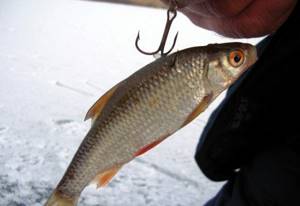
Instead of thread, you can use a simple rubber band or fishing line. In this case, the bait is not damaged at all, it remains active and tries to get rid of unnecessary devices in the tail part.
Some predators, with the exception of pike, are caught this way. When a pike intercepts the bait, its sharp teeth tear the rim made of thread or elastic.
Pike do not have the habit of attacking small fish from behind. She can easily spit out her prey if she suspects something unnatural, so often most of the pike’s bites go in vain.
How and when are live bait options used?
There are some subtleties when hooking a catch. Inexperienced fishermen hook as soon as it starts to “spin”, but in this case the actions should depend on the situation.
If the live bait is baited with its back, you need to hook it immediately. When a baitfish is caught in the lip or gills, it is worth waiting a little. It happens that the rotation of the coil slows down or stops altogether.
This may mean that the victim was grabbed by a predatory fish, which first rushed in some direction and then began to return back.
In this case, cutting will be of no use. In this case, the fisherman must slowly wind the line onto the reel and, sensing the right moment, make a hook.
The method in which live bait should be mounted depends on many circumstances:
- what kind of predatory fish the fisherman intends to catch,
- how active is she?
- what features does it differ from?
- what time is fishing planned, etc.
They try to catch perch or pike perch using live bait, which they put on their backs. The attack of pike is more sluggish; it often clings to the back of the bait. In such a situation, it is better if the bait is baited by the gills.
When swallowing live bait, the predator will be securely hooked. This method of attaching live bait is relevant for overly aggressive pikes.
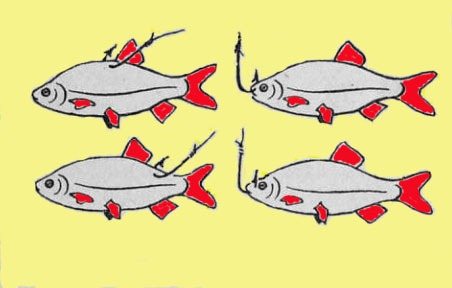
During night fishing or when the girders are located at a distance from the fisherman, using live bait by the gills will be the best way.
It should be remembered that not all live bait can be attached using this method.
Roach and crucian carp attach well to the gills, but bitterling or bleak cannot withstand this method and quickly die.
A single, double or triple hook can be used to attach live bait.
The main requirement for them will be the presence of a sharp point and a long fore-end, which makes it easier to attach live bait. The thinner the hooks, the less trauma is caused to live bait.
The advantage of passing the leader through the gills is that there are no punctures in the body of the bait, so the bait remains alive for a longer time.
With this method, the stings of the hook located near the mouth cavity are directed towards the bait, so there is no need to hook the prey, since it swallows the hook on its own.
The only thing that needs to be ensured with this method is the presence of a soft leash, allowing the baitfish to take the appropriate position.
In another method, the end of the leader is passed through the gills and the hook is hooked through the back of the bait up to the dorsal fin. The disadvantage of this method is that the nozzle is damaged and does not last long.
When passing the sting through the nostril of the nozzle, the very end of it is equipped with a piece of cambric, an elastic band, and a plastic patch, in order to avoid the fish being torn off.
This must be done very carefully so as not to hurt the brain.
How to attach live bait to a tee?
With a treble hook the situation is different. It is not advisable to hook it on the lip, since in case of a bite it can break through it.
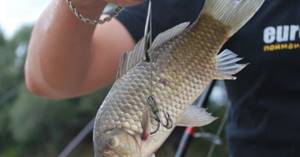
It is even more difficult to hook a treble hook onto the gills than a double hook. This method can only be used by experienced fishermen.
It is best to hook the bait behind the back with a tee, but do not forget about some features.
When a predator approaches the bait, the swallowing process does not occur immediately.
First of all, the predator will try to kill the small fish, then turn it around in order to swallow it later.
If you hook before the bait is swallowed, the predatory fish will not be hooked. When using a tee, some experience is required.
How to pick a devil for bream

The devil is an effective jig that is most catchy when ice hunting. The bait is capable of awakening both the food reflex and banal curiosity in underwater inhabitants, forcing a passive or well-fed bream to grab a tasty object.
Not every trait is equally productive. There are models that are not able to interest underwater inhabitants. The bream can only poke and butt the bait, but it will be impossible to detect it. There are jigs that encourage fish to immediately attack them, confidently sitting on the hook.
Shape and color of the trait
The result of fishing depends on the correctly chosen shape of the jig and its color. The catchy devil for bream has an elongated body that slightly widens downwards. Round short modifications almost do not work, except for small underbream, silver bream and roach.
Note! Experienced fishermen keep curved models or devils with free-hanging hooks in their ammunition.
The color of the jig must be approached carefully. The most versatile and catchy little devils are black in color, possibly with white and yellow dots or stripes. In good lighting, matte shades such as copper are used. In cloudy weather, “silver” and “gold” work.
Lure sizes
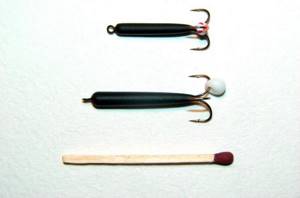
However, there is no point in using bait less than 1 cm long. The weight of the jig depends on the following factors:
- depth at the fishing site;
- presence and strength of current;
- horizon of fish parking;
- the gear used.
Since bream in most cases is caught at depths of 5 meters, the weight of the devil is selected from 0.8 grams. It happens that you have to use bait weighing 3–4 grams.
Recommended reading: Carp fish
How to properly attach live bait for pike fishing in still water?
The most convenient attachment for live bait when fishing for pike in a still body of water is considered to be attached to the back. This method is used when fishing for pike near the bottom of a reservoir using a float rod.
In this case, even a sleeping bait will look natural to the pike, since it will be positioned horizontally.
This method allows the bait to attract the attention of pike in any season, however, this is only suitable for those reservoirs where the water is stagnant. Any current can cause the bait to be positioned in an unnatural position.
Live bait is attached in the following way: the fish is pierced with one of the hooks of the tee from the bottom of the base of the dorsal fin, and a small bead is used as a stopper.
How to properly catch bream with a devil
The effectiveness of winter fishing for bream on the devil depends not only on correctly configured, balanced gear and a well-assembled set of jigs. The fisherman needs to learn to determine the time and place of his fishing. You need to master the technique of presenting bait, delve into other subtleties and nuances of fishing.
We recommend reading: Features of trout fishing with a spinning rod
Educational video about finding and catching bream with a devil.
Time and place of fishing
You can catch bream in winter day and night. During daylight hours they search for it, exploring promising areas. In the dark, they set up a tent, drill several holes and fish stationary. As a rule, weighty and trophy specimens are taken after sunset.
You need to look for bream in deep areas of the reservoir. The fisherman simply must examine:
- channel dumps;
- pits, entrances and exits from them;
- edges and slopes;
- local pits and hills;
- long ditches and ravines.
The maximum activity of bream is observed in December during the first ice. He is active and eagerly responds to the offered bait. In the dead of winter, the fish’s appetite decreases, it moves little and tries not to waste energy. Steady biting resumes at the end of winter.
Do I need bait?
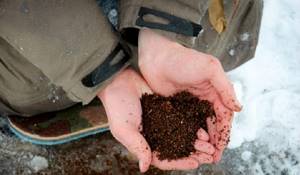
The use of bait when catching bream with a devil is in most cases justified. It allows you to attract fish to the fishing point and keep it there for a long time. Sometimes the use of a bait mixture collects a lot of small things under the hole, which interferes with a full-fledged hunt for trophy specimens. Small bream, silver bream, and roach begin to take over. Therefore, many factors must be taken into account when choosing fishing tactics and the composition of the feed.
Please note! The bait should not be very dusty, otherwise small things are guaranteed to accumulate at the fishing point.
The simplest and most effective bait consists of small feed bloodworms mixed with soil. It is driven into a special dump truck feeder, lowered to the bottom and opened there, creating a spot at the fishing point. The movements of mosquito larvae and mud from the ground attract the attention of the bream; it approaches the fishing zone, where the angler feeds the devil.
Also, fishermen without bait often use live mormysh (amphipod crustacean). It can be lowered to the bottom with a special feeder, or, if there is no current, it can be thrown directly into the hole, slightly muffled.
Naked devil or with a nozzle
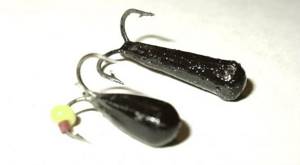
The devil on a bream can be naked, but it is much more effective to decorate it with an additional movable element. Hooking a jig on the hook will attract the attention of the fish, help provoke it to bite, and act as a point of attack.
Recommended reading: Perch in the wilderness
Some of the baits for devils include:
- multi-colored cambric;
- beads of black, white, red, yellow or green;
- sequins.
Some fishermen hang several links of a thin chain or tie a red thread, Lurex, or put on small silicone balls.
When stationary fishing, especially at night, you can attach fresh bloodworms or small earthworms to the devil’s hook. In addition to it, the larva of the burdock moth works. You need to take care of its availability in advance, preparing it in late autumn.
What methods are there for baiting bait when fishing for pike perch?
Every fisherman tries to specialize in his favorite fish. However, everyone agrees that catching pike perch is very interesting, and the taste qualities of this type of fish are significantly superior to many other species.
Pike perch has always been considered a strong and worthy predator, to catch which a fisherman must have certain experience and skills:
- You can catch fish such as pike perch using live bait throughout the year, however, it bites best in the spring before spawning and after it ends. They usually go out overnight to fish for pike perch when it’s dawn or dawn. The gear for fishing with live bait will be a float rod.
- Usually they use a fishing rod with a rod of more than three meters. An inertial coil is not used. With such gear, fishing can be especially successful in places where the current is very quiet or there is no current at all.
- Often you have to use long casts to catch pike perch with live bait, so it’s a good idea to have a medium-sized sliding float on your fishing rod, with a carrying capacity of about three grams.
The sinker is placed at a distance of thirty centimeters above the live bait, which will allow the latter to be freer. In this case, it is quite acceptable to use a single hook, which will hold the bait well. The fishing line should be soft, diameter from 0.2 millimeters to 0.3. Similar gear is used for catching pike perch using live bait from the shoreline or from boats. - Live bait can be any young fish. Crucian carp and gudgeon have proven themselves very well. They stay attached to the hook longer.
- The live bait should be hooked behind the back, two centimeters behind the head. You can use a single, double or triple hook. It is necessary to ensure that the hook matches the size of the bait used. The hook should not exceed the size of the bait fish.
- During fishing, for greater safety, live bait should be stored lowered into the cage at a considerable depth, where the water temperature is lower. No more than a dozen live baits are launched into the bucket.
Dependence of the mounting method on the gear
Methods of securing live bait on a hook are also related to the peculiarities of using a particular gear. The following pattern is observed with certain fishing techniques:
- float rod - for fishing for pike perch, the fry is caught by the lip, and in a weak current by the large fin,
- the bait is equipped with a leash, and this quality is used to pass the fishing line through the gills,
- the line is an excellent opportunity to try out all the methods of attaching live bait, because up to 100 hooks are strung on the main cord,
- fishing from a boat also allows you to use well-known hook options,
- The girder is the main technique, it is an attachment behind the back, but other types of binding are also possible.
There is a dependence on the methods of attaching the fry to the hook and on the fishing object: for pike perch and perch, this is to grab it by the back. Burbot is caught with a single sting; it doesn’t matter where to catch it.
Adviсe
You should use different methods of hooking live bait, as well as different equipment, then compare the results and draw conclusions. Experience is important in everything.
For example, such an improved system as the Jardine tackle, which does not misfire, gives a good effect. It consists of several double hooks, which are assembled onto one leash, and small hooks are soldered onto the doubles.
To keep baitfish active longer, it is necessary to maintain a cooler temperature in the water where they are kept. Cold water contains more oxygen.
- If the water in the bucket where the live bait is stored has time to heat up, you should gradually add water from the reservoir where fishing will take place. Live bait must get used to the temperature of the water in the reservoir, otherwise it will not tolerate the immediate temperature difference and will quickly die.
- If the water in the container containing the live bait becomes cloudy, it needs to be changed quickly, this way they get rid of the ammonia released by the vital activity of the live bait.

